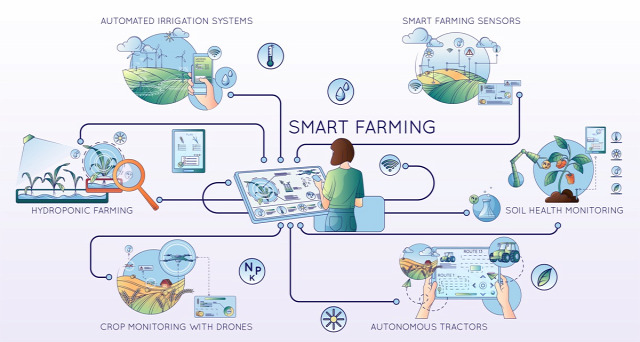
The global smart farming market is on a trajectory of revolutionary growth, reshaping traditional agricultural practices through cutting-edge technologies.
Smart farming integrates advanced technologies, such as the Internet of Things (IoT), artificial intelligence (AI), and data analytics, into agricultural operations. These technologies empower farmers with real-time data, enabling informed decision-making, resource optimization, and sustainable practices.
The Global Smart Farming Market was valued at $15.06 billion in 2022 and is expected to reach $33.0 billion in 2027, following a CAGR of 16.99% during 2022-2027.
The anticipated expansion of the worldwide smart farming market is projected to stem from the heightened adoption of IoT and artificial intelligence, the digitization of agricultural operations, and an increased reliance on advanced technologies to augment production on a global scale.
Technological Landscape and Market Dynamics
-
Rising Demand for Precision Agriculture: The increasing need for precision in agriculture is a primary driver of the smart farming market. Precision agriculture techniques, enabled by sensors and IoT devices, contribute to optimized resource utilization, reduced environmental impact, and enhanced overall productivity.
-
IoT in Agriculture: The widespread adoption of IoT devices in agriculture is a game-changer. Smart sensors, drones, and connected devices gather data on soil health, weather conditions, and crop status, providing farmers with actionable insights for improved yield and resource efficiency.
-
Data-Driven Decision-Making: Smart farming emphasizes data-driven decision-making. The integration of AI and data analytics enables farmers to analyze vast datasets, offering predictions on crop yields, disease outbreaks, and optimal planting times, leading to more informed and efficient operations.
-
Sustainable Agriculture Practices: Sustainability is a key focus of the smart farming market. Technologies promoting resource efficiency, reduced chemical usage, and environmentally conscious practices align with the global shift towards sustainable agriculture.
Access More: Get Free Detailed Insights on Global Smart Farming Market Report by BIS Research.
Regional Perspectives
North America: North America leads the adoption of smart farming practices. The region's advanced technological infrastructure, coupled with the large-scale farming landscape, fosters the integration of precision agriculture technologies.
Europe: European countries are embracing smart farming as part of their commitment to sustainable agriculture. The European Union's Common Agricultural Policy (CAP) encourages the adoption of digital technologies for enhanced productivity and environmental stewardship.
Asia-Pacific: In the Asia-Pacific region, countries like India and China are witnessing a surge in smart farming initiatives. The adoption of technology to address challenges like water scarcity, labor shortages, and the need for increased food production is driving market growth.
Anticipated Technological Trends
-
Robotics and Automation: The incorporation of robotics and automation is a rising trend in smart farming. Autonomous tractors, robotic harvesters, and drone technologies streamline labor-intensive tasks, boosting efficiency and reducing operational costs.
-
Blockchain for Supply Chain Transparency: Blockchain technology is gaining prominence for enhancing transparency in the agricultural supply chain. Smart farming solutions leverage blockchain for traceability, ensuring the integrity and authenticity of farm-to-fork processes.
-
Edge Computing: Edge computing is becoming integral to smart farming systems. Processing data closer to the source (on the edge) reduces latency, enabling real-time decision-making in the field without reliance on centralized cloud computing.
Some Key Companies Based on Precision Farming & Farm Management
-
Ag Leader Technology
-
AGCO Corporation
-
CNH Industrial N.V.
-
Deere & Company
-
Hexagon Agriculture
-
Kubota Corporation
-
Climate LLC
-
Trimble Inc.
-
BASF SE
-
CropX inc.
Future Outlook and Opportunities
-
6G Connectivity Integration: The integration of 6G connectivity is poised to elevate smart farming capabilities. High-speed, low-latency networks will enhance the real-time communication of devices, facilitating seamless connectivity and data transfer across the agricultural landscape.
-
Collaboration for Interoperability: Collaboration among technology providers for interoperability is crucial for the future of smart farming. Integrated systems that allow different devices and platforms to work together seamlessly will enhance the overall efficiency of agricultural operations.
-
Continued Emphasis on Sustainability: The smart farming market will continue to evolve with a strong emphasis on sustainable practices. Technologies that promote precision, reduce waste, and enhance environmental consciousness will shape the future of agriculture.
Conclusion
The Global Smart Farming Industry is poised for transformative growth, driven by technological innovations that redefine the agricultural landscape. As farmers increasingly adopt smart farming practices, the industry is set to usher in an era of sustainable, efficient, and data-driven agriculture.

